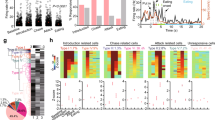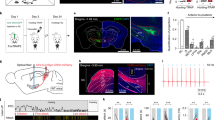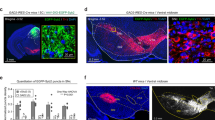Abstract
The neural substrates for predatory hunting, an evolutionarily conserved appetitive behavior, remain largely undefined. Photoactivation of zona incerta (ZI) GABAergic neurons strongly promotes hunting of both live and artificial prey. Conversely, photoinhibition of these neurons or deletion of their GABA function severely impairs hunting. Here electrophysiological recordings reveal that ZI neurons integrate prey-related multisensory signals and discriminate prey from non-prey targets. Visual or whisker sensory deprivation reduces calcium responses induced by prey introduction and attack and impair hunting. ZI photoactivation largely corrects the hunting impairment caused by sensory deprivations. Motivational and reinforcing assays reveal that ZI photoactivation is associated with a strong appetitive drive, causing repetitive self-stimulatory behaviors. These ZI neurons project to the periaqueductal gray matter to induce hunting and motivation. Thus, we have delineated the function of ZI GABAergic neurons in hunting, which integrates prey-related sensory signals into prey detection and attack and induces a strong appetitive motivational drive.
This is a preview of subscription content, access via your institution
Access options
Access Nature and 54 other Nature Portfolio journals
Get Nature+, our best-value online-access subscription
$29.99 / 30 days
cancel any time
Subscribe to this journal
Receive 12 print issues and online access
$209.00 per year
only $17.42 per issue
Buy this article
- Purchase on Springer Link
- Instant access to full article PDF
Prices may be subject to local taxes which are calculated during checkout






Similar content being viewed by others
Data availability
The data that support the findings of this study are available from the corresponding authors upon reasonable request.
Code availability
The code that supports the findings of this study is available from the corresponding authors upon reasonable request.
References
Volkmann, J., Daniels, C. & Witt, K. Neuropsychiatric effects of subthalamic neurostimulation in Parkinson disease. Nat. Rev. Neurol. 6, 487–498 (2010).
Morgan, J. C. et al. Self-stimulatory behavior associated with deep brain stimulation in Parkinson’s disease. Mov. Disord. 21, 283–285 (2006).
Kim, H. J., Jeon, B. S. & Paek, S. H. Nonmotor symptoms and subthalamic deep brain stimulation in Parkinson’s disease. J. Mov. Disord. 8, 83–91 (2015).
Caire, F., Ranoux, D., Guehl, D., Burbaud, P. & Cuny, E. A systematic review of studies on anatomical position of electrode contacts used for chronic subthalamic stimulation in Parkinson’s disease. Acta Neurochir. 155, 1647–1654 (2013).
Zhang, X. & van den Pol, A. N. Rapid binge-like eating and body weight gain driven by zona incerta GABA neuron activation. Science 356, 853–859 (2017).
Liu, K. et al. Lhx6-positive GABA-releasing neurons of the zona incerta promote sleep. Nature 548, 582–587 (2017).
Roger, M. & Cadusseau, J. Afferents to the zona incerta in the rat: a combined retrograde and anterograde study. J. Comp. Neurol. 241, 480–492 (1985).
Power, B. D., Leamey, C. A. & Mitrofanis, J. Evidence for a visual subsector within the zona incerta. Vis. Neurosci. 18, 179–186 (2001).
Chometton, S. et al. The rostromedial zona incerta is involved in attentional processes while adjacent LHA responds to arousal: c-Fos and anatomical evidence. Brain Struct. Funct. 222, 2507–2525 (2017).
Tait, D. S., Phillips, J. M., Blackwell, A. D. & Brown, V. J. Effects of lesions of the subthalamic nucleus/zona incerta area and dorsomedial striatum on attentional set-shifting in the rat. Neuroscience 345, 287–296 (2017).
Perier, C., Tremblay, L., Feger, J. & Hirsch, E. C. Behavioral consequences of bicuculline injection in the subthalamic nucleus and the zona incerta in rat. J. Neurosci. 22, 8711–8719 (2002).
Murer, M. G. & Pazo, J. H. Circling behaviour induced by activation of GABAA receptors in the subthalamic nucleus. Neuroreport 4, 1219–1222 (1993).
Milner, K. L. & Mogenson, G. J. Electrical and chemical activation of the mesencephalic and subthalamic locomotor regions in freely moving rats. Brain Res. 452, 273–285 (1988).
Supko, D. E., Uretsky, N. J. & Wallace, L. J. Activation of AMPA/kainic acid glutamate receptors in the zona incerta stimulates locomotor activity. Brain Res. 564, 159–163 (1991).
Huang, Y. H. & Mogenson, G. J. Differential effects of incertal and hypothalamic lesions on food and water intake. Exp. Neurol. 43, 276–280 (1974).
Walsh, L. L., Halaris, A. E., Grossman, L. & Grossman, S. P. Some biochemical effects of zona incerta lesions that interfere with the regulation of water intake. Pharm. Biochem. Behav. 7, 351–356 (1977).
Mitofanis, J. Evidence for an auditory subsector within the zona incerta of rats. Anat. Embryol. 205, 453–462 (2002).
Shaw, V. & Mitrofanis, J. Anatomical evidence for somatotopic maps in the zona incerta of rats. Anat. Embryol. 206, 119–130 (2002).
Mitrofanis, J. Some certainty for the “zone of uncertainty”? exploring the function of the zona incerta. Neuroscience 130, 1–15 (2005).
Power, B. D. & Mitrofanis, J. Zona incerta: substrate for contralateral interconnectivity in the thalamus of rats. J. Comp. Neurol. 436, 52–63 (2001).
Power, B. D. & Mitrofanis, J. Evidence for extensive inter-connections within the zona incerta in rats. Neurosci. Lett. 267, 9–12 (1999).
Watson, G. D., Smith, J. B. & Alloway, K. D. The zona incerta regulates communication between the superior colliculus and the posteromedial thalamus: implications for thalamic interactions with the dorsolateral striatum. J. Neurosci. 35, 9463–9476 (2015).
Power, B. D. & Mitrofanis, J. Ultrastructure of afferents from the zona incerta to the posterior and parafascicular thalamic nuclei of rats. J. Comp. Neurol. 451, 33–44 (2002).
Kolmac, C. I., Power, B. D. & Mitrofanis, J. Patterns of connections between zona incerta and brainstem in rats. J. Comp. Neurol. 396, 544–555 (1998).
Power, B. D., Kolmac, C. I. & Mitrofanis, J. Evidence for a large projection from the zona incerta to the dorsal thalamus. J. Comp. Neurol. 404, 554–565 (1999).
Won, R. Motivation: A Biobehavioural Approach (Cambridge Univ. Press, 2000).
Furigo, I. C. et al. The role of the superior colliculus in predatory hunting. Neuroscience 165, 1–15 (2010).
Butler, K. Predatory behavior in laboratory mice: strain and sex comparisons. J. Comp. Physiol. Psychol. 85, 243–249 (1973).
Han, W. et al. Integrated control of predatory hunting by the central nucleus of the amygdala. Cell 168, 311–324.e318 (2017).
Hoy, J. L., Yavorska, I., Wehr, M. & Niell, C. M. Vision drives accurate approach behavior during prey capture in laboratory mice. Curr. Biol. 26, 3046–3052 (2016).
Favaro, P. D. et al. The influence of vibrissal somatosensory processing in rat superior colliculus on prey capture. Neuroscience 176, 318–327 (2011).
Mota-Ortiz, S. R. et al. The periaqueductal gray as a critical site to mediate reward seeking during predatory hunting. Behav. Brain Res. 226, 32–40 (2012).
Comoli, E., Ribeiro-Barbosa, E. R. & Canteras, N. S. Predatory hunting and exposure to a live predator induce opposite patterns of Fos immunoreactivity in the PAG. Behav. Brain Res. 138, 17–28 (2003).
Comoli, E., Ribeiro-Barbosa, E. R., Negrao, N., Goto, M. & Canteras, N. S. Functional mapping of the prosencephalic systems involved in organizing predatory behavior in rats. Neuroscience 130, 1055–1067 (2005).
Li, Y. et al. Hypothalamic circuits for predation and evasion. Neuron 97, 911–924.e5 (2018).
Park, S. G. et al. Medial preoptic circuit induces hunting-like actions to target objects and prey. Nat. Neurosci. 21, 364–372 (2018).
Lin, J. Y., Lin, M. Z., Steinbach, P. & Tsien, R. Y. Characterization of engineered channelrhodopsin variants with improved properties and kinetics. Biophys. J. 96, 1803–1814 (2009).
Vong, L. et al. Leptin action on GABAergic neurons prevents obesity and reduces inhibitory tone to POMC neurons. Neuron 71, 142–154 (2011).
Govorunova, E. G., Sineshchekov, O. A., Janz, R., Liu, X. & Spudich, J. L. Natural light-gated anion channels: a family of microbial rhodopsins for advanced optogenetics. Science 349, 647–650 (2015).
Cui, Y. et al. A central amygdala–substantia innominata neural circuitry encodes aversive reinforcement signals. Cell Rep. 21, 1770–1782 (2017).
Chou, X. L. et al. Inhibitory gain modulation of defense behaviors by zona incerta. Nat. Commun. 9, 1151 (2018).
Chen, T. W. et al. Ultrasensitive fluorescent proteins for imaging neuronal activity. Nature 499, 295–300 (2013).
Zhao, Z. D. et al. A hypothalamic circuit that controls body temperature. Proc. Natl Acad. Sci. USA 114, 2042–2047 (2017).
Shang, C. et al. A subcortical excitatory circuit for sensory-triggered predatory hunting in mice. Nat. Neurosci. https://doi.org/10.1038/s41593-019-0405-4 (2019).
Hodos, W. Progressive ratio as a measure of reward strength. Science 134, 943–944 (1961).
Pei, Y., Rogan, S. C., Yan, F. & Roth, B. L. Engineered GPCRs as tools to modulate signal transduction. Physiology 23, 313–321 (2008).
Tervo, D. G. et al. A designer AAV variant permits efficient retrograde access to projection neurons. Neuron 92, 372–382 (2016).
Ewert, J. P. Neural correlates of key stimulus and releasing mechanism: a case study and two concepts. Trends Neurosci. 20, 332–339 (1997).
Betley, J. N. et al. Neurons for hunger and thirst transmit a negative-valence teaching signal. Nature 521, 180–185 (2015).
Bandler, R. J. Jr, Chi, C. C. & Flynn, J. P. Biting attack elicited by stimulation of the ventral midbrain tegmentum of cats. Science 177, 364–366 (1972).
Berridge, K. C. Motivation concepts in behavioral neuroscience. Physiol. Behav. 81, 179–209 (2004).
Paxinos, G. & Franklin, K. B. J. The Mouse in Sterotaxic Coordinates 3rd edn (Academic Press, 2008).
Douglass, A. M. et al. Central amygdala circuits modulate food consumption through a positive-valence mechanism. Nat. Neurosci. 20, 1384–1394 (2017).
Do-Monte, F. H., Minier-Toribio, A., Quinones-Laracuente, K., Medina-Colon, E. M. & Quirk, G. J. Thalamic regulation of sucrose seeking during unexpected reward omission. Neuron 94, 388–400.e384 (2017).
Wei, Y. C. et al. Medial preoptic area in mice is capable of mediating sexually dimorphic behaviors regardless of gender. Nat. Commun. 9, 279 (2018).
Tseng, W. T., Yen, C. T. & Tsai, M. L. A bundled microwire array for long-term chronic single-unit recording in deep brain regions of behaving rats. J. Neurosci. Methods 201, 368–376 (2011).
Guo, L., Walker, W. I., Ponvert, N. D., Penix, P. L. & Jaramillo, S. Stable representation of sounds in the posterior striatum during flexible auditory decisions. Nat. Commun. 9, 1534 (2018).
Chen, X. & Li, H. Ar control: an arduino-based comprehensive behavioral platform with real-time performance. Front. Behav. Neurosci. 11, 244 (2017).
Acknowledgements
The authors thank the following individuals: M. Luo, H. Hu, C. Zhan, J. Liao, H. Zhu and Y. Zou for sharing reagents; X. Li and the Molecular Imaging Core Facility (MICF) of the School of Life Science and Technology, ShanghaiTech University, for microscopy imaging; Y. Xiong and the Molecular Cellular Core for slices and staining; all members of the Shen Lab and the “Shen Xian Hui (NPC)” Wechat group for valuable discussion. The authors also thank staff members from the Shanghai Model Organisms Center and Animal Facility at NFPS, Zhangjiang Lab, China. This study is funded by the National Natural Science Foundation of China (no. 91857104 and no. 31771169 to W.L.S.; no. 91432107 and no. 31671105 to H.L.), the Shanghai Municipal Education Commission (no. 2019-01-07-00-10-E00058 to W.L.S.), the Science Fund for Creative Research Group of China (no. 61721092 to H.L.), the Director Fund of the Wuhan National Laboratory for Optoelectronics (to H.L.), the Thousand Young Talents Program of China (to W.L.S.), the Shanghai Pujiang Talent Award (no. 2018X0302-101-01 to W.S.) and the ShanghaiTech University start-up fund (to W.L.S.).
Author information
Authors and Affiliations
Contributions
Z.-D.Z., Zongming C., X.X. and M.H. performed most of the experiments. H.X., X.J., L.Q., C.S. and Y.Y. performed the behavioral evaluations. J.L. and X.N. performed the immunostaining. F.C. and Zijun C. performed the electrophysiology. Y.C. performed the multichannel recordings. Z.-D.Z., J.H., W.S., P.C., H.L. and W.L.S. designed the experiments. Z.-D. Z., Zongming C., M.H., H.L. and W.L.S. wrote the manuscript.
Corresponding authors
Ethics declarations
Competing interests
The authors declare no competing interests.
Additional information
Journal peer review information: Nature Neuroscience thanks Jennifer Hoy, Daesoo Kim and the other, anonymous, reviewer(s) for their contribution to the peer review of this work.
Publisher’s note: Springer Nature remains neutral with regard to jurisdictional claims in published maps and institutional affiliations.
Supplementary information
Supplementary Video 1
Home-cage behaviors. This video shows that photoactivation of zona incerta GABAergic neurons (ZImVgat-ChIEF) in food-supplied home-cages induces undirected-gnawing, biting objects, or binge-like eating. (Behavioral definitions: undirected gnawing, mice executed fictive-eating or gnawing uneatable bedding materials or feces; binge-like eating, mice rapidly bit and consumed food pellets; biting objects, mice bit on the food container or water nozzle.)
Supplementary Video 2
Photoactivation-induced bite attack. This video shows that one pulse of 100-ms photoactivation of zona incerta GABAergic neurons is sufficient to induce a bite attack on bedding materials.
Supplementary Video 3
ZI glutamatergic neurons did not promote hunting. This video shows that photoactivation of zona incerta glutamatergic neurons does not induce attacking, gnawing or eating of food or bedding materials.
Supplementary Video 4
Hunting of adult crickets. This video shows that adult crickets are very defensive and that photoactivation of zona incerta GABAergic neurons promotes hunting of adult crickets.
Supplementary Video 5
Attacking of artificial prey. This video shows that photoactivation of zona incerta GABAergic neurons elicits attacking of artificial prey.
Supplementary Video 6
Hunting behaviors of cricket-naive mice. This video shows that photoactivation of zona incerta GABAergic neurons increases attacking frequency in cricket-naive mice.
Supplementary Video 7
Photoactivation did not induce aggression. This video shows that photoactivation of zona incerta GABAergic neurons does not evoke attacking of male and female mice.
Supplementary Video 8
Photoinhibition interrupted hunting and eating. This video shows that photoinhibition of zona incerta GABAergic neurons in ZImVgat-GtACR mice abolishes cricket attacking, and eating.
Rights and permissions
About this article
Cite this article
Zhao, Zd., Chen, Z., Xiang, X. et al. Zona incerta GABAergic neurons integrate prey-related sensory signals and induce an appetitive drive to promote hunting. Nat Neurosci 22, 921–932 (2019). https://doi.org/10.1038/s41593-019-0404-5
Received:
Accepted:
Published:
Issue Date:
DOI: https://doi.org/10.1038/s41593-019-0404-5
This article is cited by
-
Inhibitory medial zona incerta pathway drives exploratory behavior by inhibiting glutamatergic cuneiform neurons
Nature Communications (2024)
-
Ketogenic diet-produced β-hydroxybutyric acid accumulates brain GABA and increases GABA/glutamate ratio to inhibit epilepsy
Cell Discovery (2024)
-
Control of feeding by a bottom-up midbrain-subthalamic pathway
Nature Communications (2024)
-
Somatostatin-Positive Neurons in the Rostral Zona Incerta Modulate Innate Fear-Induced Defensive Response in Mice
Neuroscience Bulletin (2023)
-
Methcathinone Increases Visually-evoked Neuronal Activity and Enhances Sensory Processing Efficiency in Mice
Neuroscience Bulletin (2023)



